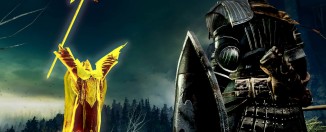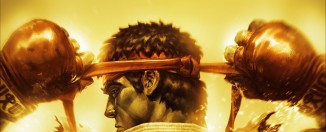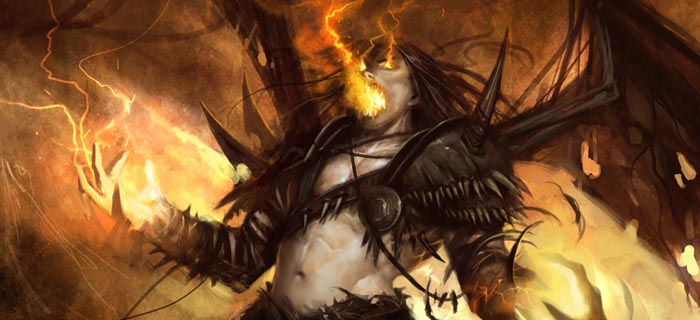Get Good: Super Street Fighter IV in 7 steps
While Top Tier Tactics has previously addressed the requisite skills for tournament play and etiquette for Street Fighter, there wasn’t enough attention paid to the fundamentals that will prevent you from outright losing every match you play. This article explains how to become a mediocre player in as few steps as possible. While this piece is intended for novices, fisticuffs experts should probably consult the more advanced Street Fighter Tournament Guide for pro-level tips.
If there’s one complaint regarding fighting games, it’s “Namco Capcom, please stop the franchise DLC-milking.” If there’s a second complaint about the genre, it’s that for the uninitiated (read: you haven’t spent the last decade practicing), fighting games are simply too complex, obtuse, and fast-paced for novices to pick up and learn. It’s understandable: how are you supposed to know what to do when you’ve been killed before you even realized you were supposed to block?
Street Fighter IV and Super Street Fighter IV are, without doubt, among the easiest of fighting games to get into. While they share the ridiculous skill ceilings of many of their contemporaries and predecessors, the slower pace and minimalist style means bludgeoning Japanese schoolgirls and Amazonian circus freaks has never been easier. There aren’t any flashy HUD elements or air-roll wavedash roman cancels, and most characters fall into one of a few basic categories.
With that in mind, Top Tier Tactics presents the fastest way to Get Good at Super Street Fighter 4 in just 7 easy steps.
#1: Rock, paper, throw… jump?
Street Fighter 4, like most games in the series, is ultimately an elaborate game of rock, paper, scissors. You know all those punches and kicks you can throw out? Consider them scissors. A block (rhymes with rock!) beats attacks by canceling out (most of) their damage and, in some cases, leaving you at a strategic advantage. Throws are the paper that suffocate block rocks, and are their natural counter. While many new players find constant blocking cheap, a static defense is demolished with a throw. While some players scorn throws, they can be outranged by most attacks, or just by jumping.
While there are many exceptions, the basic thing you want to keep in mind is that if your opponent is trying to attack, you should be blocking. If they’re blocking, you should throw, and you want to preempt throws with jumps or just by being out of range, where you can smack them with your limbs. This sounds simple, and it is, but many newbies with no strategy just button mash and wonder why they’re losing with a random mix of attacks.
#2: Playing it safe
You’ve probably heard that some moves aren’t “safe,” but what does that mean? A move that isn’t safe is one that, if blocked, allows the person blocking to recover quicker than the attacker, letting the blocker gain momentum and swing the match in his or her favor.
And important part of getting better is learning which moves a character has are unsafe if blocked, since this knowledge will allow you to punish your opponent’s mistakes. For instance, if you knew Hakan’s Oil Slide was unsafe on block at most ranges, but safe on block at its maximum extension, you would know when to punish him and when to jump from his impending throw. If you didn’t know about when his attack was safe, you would always block or always attempt to punish him and fail, allowing him to score free damage due to your ignorance of his moves.
Another thing many players don’t realize is how unsafe jumping is. While you’re jumping, you can’t block, so you can be easily hurt, but more importantly is that by jumping, you telegraph your position and options for the entire duration of the jump. Just think: while you’re on the ground, you could stand, block, attack, grab, or tons of other stuff. When you’re in the air, usually the only things you can do are attack or be attacked!
The best ways to learn what’s safe is to read/watch character guides online, or just play as the character online. You’ll find out really fast that Gouken’s sliding palm isn’t always safe on block after you get KO’ed every time you use it!
#3: Progressive punishes
No matter how good your opponent is, eventually he or she will mess up. Maybe it’ll be a whiffed throw (because you jumped!) or an unsafe attack or a dropped combo. Many new players fail to capitalize on these mistakes because they either don’t have a plan or they’re not capable of executing the 20-hit combo they read about online.
Begin with simple punishes, and work up to better combos as you get more confident. Many professionals look down on using a basic throw, but if that’s all you can do, start with that. Get ready to throw at any time your opponent is open for it, then do it. As your reactions improve, try doing your Ultra Combo on reaction to whiffed moves, or basic combos that end in a special move. If all you did every match was perfectly defend against your opponent’s attacks with blocks and jumps, you could win with a single punish.
#4: In space, nobody can hear you lose
Every character has a range at which that character’s moves are most effective. For grapplers like Zangief and short-range fighters like Cammy, it’s usually right in your opponent’s face. For someone like Ryu, who can control the horizontal field with fireballs and easily punish poorly-timed jumps with shoryukens, a mid range strategy works best.
A match of Street Fighter is often won or lost by which player controls space the best. If you play Makoto or Balrog and spend the entire round running away from Dhalsim, odds are you aren’t going to win, since Dhalsim can hurt you at full screen and all you can do is experience the receiving end of yoga pain. For most characters, your best range is at the tip of their attacks, since that’s the farthest they can reach without exposing themselves to faster, shorter-range moves. Always aim to keep your opponent at this range and you’ll find you take fewer unnecessary hits while being in a better position to capitalize on opponents’ mistakes.
#5: Patience comes before mind reading
While the skill of yomi (gameplay intuition) is useful at the mid and upper levels of play, until you’re actually a competent player, your attempts to get in your opponent’s head will most likely land you in your opponent’s fists. The reality is that a skilled opponent is 10x more likely to be able to guess your next move than the inverse, so your attempts to “psychically” predict a move and counter with a random Ultra Combo will most likely be anticipated, blocked, and punished.*
Instead, spend more time actively asking yourself, “What are my opponent’s options?” then, “Why did my opponent choose to do that?” after it happens. Instead of pushing the offensive, pause occasionally and see what your foe does, and think about why. It is only through this kind of reflection and the wisdom gained from experience that your guesses will swing from fail-tastically wrong to Daigo Tier right.
#6: For god’s sake, just fucking block
When most terrible players lose, they ask themselves “What the fuck, fucking gay-ass lag!” While that’s technically not a question, players who make such utterances aren’t technically human beings, either. The reality is that most bad players lose because they simply didn’t block enough or correctly.
While you’re waiting for your opponent to mess up (#3) or watching how they react to a small pause (#5), blocking is the safest bet against all but the most throw-centric characters.** Blocking negates all damage from normal attacks, and cuts damage from specials by a huge margin (normally called chip damage). As noted before, if you were able to block 100% of your opponent’s moves, you’d only ever get hit by chip damage and throws, meaning one or two well timed punishes on your end would win the match.
Of course, it’s not that easy, but it’s not hard either. Most attacks can be blocked while standing or crouching. Crouching attacks can only be blocked while crouching, and jumping attacks can (usually) only be blocked while standing. Some characters have special or command moves that must be blocked high even though they didn’t jump, but these moves are fairly slow and obvious once you know what they look like. While in the air, characters cannot block – another reason to limit jumping as much as possible.
The only real downside to blocking constantly is that your opponent will either chip you with special moves or eventually wise up and go for throws. Also, an attacker gets more Super Meter than the blocker gets. But aside from these considerations, blocking is usually much safer than mashing out moves or performing “psychic” reactions.
If you find you’re being locked down while blocking, a good alternative can be back dashing. For many characters, the back dash is invincible for part of the animation, allowing you to evade a hit or two. Even the non-invulnerable portion of a back dash usually counts as an air hit, meaning you can’t be comboed after it.
#7: Focus pocus
The most important differentiation Street Fighter 4 makes from its predecessors is the Focus Attack system. Focus Attacks have a lot of uses, and understanding them all is important to gradually improving your gameplay.
- Level 1: If you just tap MP+MK, your character will perform a quick attack. If it hits the opponent while they’re in the middle of an attack animation (a counter hit), they will crumble to their knees, giving you a free punish
- Level 2: If you hold down MP+MK, your character will focus and charge up, flashing white to indicate level 2 focus. During this charge, your character can be hit by any move without getting smacked around, allowing you to effectively absorb it. If, however, you’re hit more than once or by an Armor Break (some moves break focus), you’ll take extra damage and lose focus. When you release a Focus Attack after the level 2 flash, hitting your opponent will crumple him/her as long as they’re not blocking.
- Level 3: If you continue to hold down MP+MK, your character will flash white again and automatically complete the Focus Attack animation. A level 3 Focus Attack cannot be blocked (blocking it will result in a crumple), breaks Armor (will beat some moves and level 1 or 2 Focus Attacks), and crumples your opponent.
For every level of Focus Attack, if you input a dash (forward or backward) right as or right after the attack hits your opponent (whether they block or get hit), your character will immediately run in the desired direction. You can forward dash to be in a better position to combo a crumpled opponent on hit, or back dash to buy you some space if they blocked it. If your Focus Attack misses, however, you won’t be able to cancel, and will be very vulnerable.
For level 2, if you decide mid-charge that your attack is a bad idea, you can dash while still holding MP+MK to cancel your charge into a dash. Your Focus Attack will not even animate; you’ll just dash. This can be used to abort your attack, absorb fireballs, or fake out your opponent. Once you’ve charged to level 3, you can no longer cancel a Focus Attack with a dash, so use this attack sparingly. An opponent who sees or predicts this attack can easily punish you with almost anything.
With levels 2 and 3 of Focus Attack, the damage you absorb from hits taken is temporary. It’ll show up as gray on your health bar, and as long as you don’t get hit while it’s regenerating, you’ll gain it all back. In addition, the damage you absorb will still build your Ultra Meter, so smart Focus Attack use can give you better punish opportunities!
In addition to all these techniques, you can input a Focus Attack in the middle of most other moves and special moves to cancel their animation. From there, you can let go for some added damage from the Focus Attack, or input a dash for a chance at a more demanding combo. This is a lot more complicated, and you should probably refer to a guide focused solely on Focus Attack Dash Cancel (FADC) combos for details.
Summary
These Super Street Fighter 4 tips aren’t meant to be all-inclusive; they’re just meant to be strategic points to help you evaluate what’s holding you back from being a better player. As with any game, experience is the best teacher, but in the absence of an actually useful instruction manual or training mode, I hope this Get Good article can help you overcome your reservations and exact sweet vengeance upon your rivals.
Do you have other Street Fighter tips? Let us know in the comments. Is there another game you want to see a Get Good article discuss? Contact Top Tier Tactics now!
*And laughed at.
**Zangief, T. Hawk, Hakan, Abel, and annoying-as-shit Dan Hibkis








Forget this guide. Now here is my guide to win (way better btw, Wing is a scrub :P) :
1. Choose Dan and taunt number 5 or 9
2. Everything you need to know about Dan : Dankyaku
3. Taunt every time you can
4. Your opponent gets mad and start to do stupid things
5. Super into Ultra1
6. Profit
“Most attacks can be blocked while standing or crouching. Crouching attacks can only be blocked while crouching, and jumping attacks can (usually) only be blocked by jumping. ”
Might want to fix this. I think you meant “and jumping attacks can (usually) only be blocked by standing. ” since you said earlier that you can’t block whilst jumping.
Oh oops! Fixed right now!
Well this is an ok general guide it might be useful against normal opponents and CPU opponents like Seth who spam grabs just cause they think its great.
Using patience before mind reading is one of the greatest ideas in this article for scrubs like me to know because its true that a lot of opponents in Street Fighter and Smash are quite good at reading moves and patterns and it takes equal patience to deal with that.
About using taunts and Dan that could be a viable Strategy depending on whether you know that your human opponent can be provoked into a bad state of mind to do stupid stuff or if your human opponent will just punish the taunt.
As for tough AI opponents taunting any of those only makes your situation worse.
This is my opinion from a Street Fight Scrub’s point of view hopefully I’ll sometime be able to understand Street Fighter as well as Smash Bros then understand both of them consistently